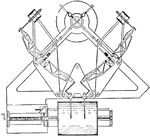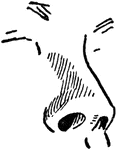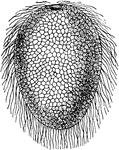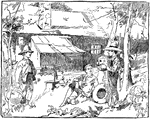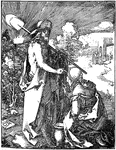Anterior View of Human Right Femur
"Anterior View of Human Right Femur. ec, external condyle; etu, external tuberosity; ic, internal condyle;…

Posterior View of Left Femur of Horse
"Posterior View of Left Femur of a Horse. h, head; gtr, great trochanter; ttr, third trochanter; ltr,…

Great Arrow Touring Car
An illustration of the "four-cylinder, 40-45 horse-power, seven passenger Great Arrow Touring Car."…
Terminal Moraines
Bird's eye view of about 2 square miles of terminal moraine. Lakes shown by horizontal shading; swamps…

First Cycle of Erosion
A coastal plain in the first cycle of erosion. The presence of two hard layers produces a terraced cuesta…

American Falls, Niagara
Section of the American Falls, Niagara. In front of the falls lie the larger blocks of Lockport dolomite,…
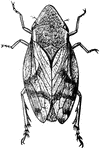
Dorsal View of Froghopper
Aphrophora quadrangularis is a species of Froghopper, an insect in the order Hemiptera.
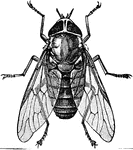
Dorsal View of Horsefly
Tabanus americanus is a species of biting horsefly in the Tabanidae family of horseflies. It was also…

Stepped Gauge
"Stepped gage, a form of male or plug gage in which a series of external gages are combined, each projecting…
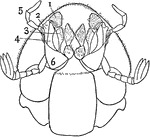
Ventral View of Dung Beetle
"Under Surface of Head of Tumble-bug (Copris carolina), about four times natural size. 1, galea; 2,…
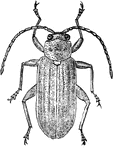
Dorsal View of Leaf Beetle
Galeruca notata is a beetle species in the Chrysomelidae family of leaf beetles.
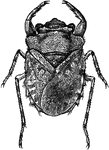
Dorsal View of Toad Bug
Galgulus oculatus is a true bug species in the Gelastocoridae family of toad bugs.

Galleries of Cathedral of Amiens
"Galleries of the west front of the Cathedral of Amiens, 13th century, illustrating treatment of galleries…

Man & Woman with Large Oak Barrel
An illustration of a man and woman standing in front of a extremely large oak barrel.

Skull of Common Fowl
"Typical Skull of Common Fowl (Galliformes). A, side view: sa, surangular bone of mandible; ar, articular…

Dorsal View of Gall Moth
Gelechia gallae-solidaginis is a species of gall moth, an insect in the Gelechiidae family of Gelechiid…
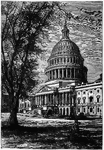
Capitol Building
The United States Capitol serves as the seat of government for the United States Congress, the legislative…
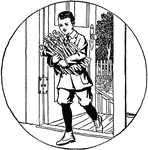
Boy Carrying Firewood Through Doorway
An illustration of a boy carrying an armful of firewood through the front doorway of a house.

Kiwi
Kiwi, Apteryx australis, of the South Island, is lighter (than the Apteryx mantelli of North Island),…
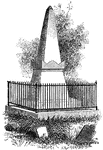
Grave Marker with RIP
An obelisk shaped grave marker with RIP (rest in peace) inscribed on the front. Marker is surrounded…
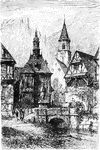
Black Forest Village
View of a village in the Schwartzwald, or Black Forest. The Black Forest stands in the elbow formed…
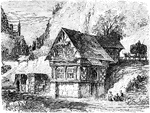
Peasant's House in the Black Forest
View of a peasant's house in the Black Forest. The scene includes an ox cart loaded with hay, children…
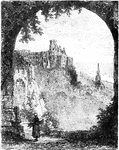
Heidelberg Castle Viewed from Terrace
View of the castle framed by an arch. A landmark of Heidelberg, the castle ruins are among the most…
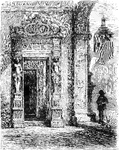
Interior of Heidelberg Castle
Interior view of Heidelberg Castle with elaborately carved doorway and part of a courtyard.
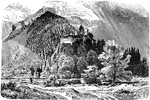
Castle of Hohenaschau
Schloss Hohenaschau, is the dominating feature in the town of Aschau im Chiemgau in Bavaria. The huge…
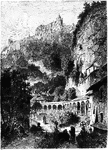
Peter's Churchyard in Salzburg
The collegiate church of St. Peter was built in the Romanesque style in the twelfth century. The burial…
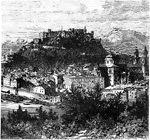
View of Salzburg
Salzburg was a city state in the Roman empire until 1805, when it was conquered by the Austrian army.…

Hotel De Ville
Hotel De Ville was constructed about 1370 in the second half of the fourteenth century. Frescos at one…

Lintz on the Dabube
A picturesque view of Lintz (Linz) on the Danube with a small number of buildings on the river banks.…

View of Lintz
A picturesque view of the Lintz (Linz) city center. Lintz was founded by the Romans, who called it "Lentia."…

The Gloriette at Schönbrunn
The Gloriette at Schönbrunn, a elegant pavilion is a miniature reproduction of the Palace of Schönbrunn.…

The Belvedere Garden
The Belvedere is a baroque palace complex built by Prince Eugene of Savoy Vienna, Austria. This view…

St. Stephen's Cathedral Pulpit
The Cathedral of St. Stephen, also called Stephansdom, stands in the heart of old Vienna. The Cathedral…
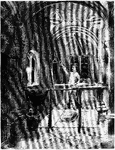
Striking the Christmas Chimes at St. Stephen's Cathedral, Vienna
View of man striking the Christmas chimes at the Cathedral of St. Stephen, also called Stephansdom,…

Dorsal View of Gastrochaena
"Dorsal View of Gastrochaena. The ventral view shows the dried mantle with pedal perforation." -Whitney,…

Ventral View of Gastrochaena
"Ventral View of Gastrochaena. The ventral view shows the dried mantle with pedal perforation." -Whitney,…

Lateral View of Gastrochaena
"Lateral View of Gastrochaena. The ventral view shows the dried mantle with pedal perforation." -Whitney,…
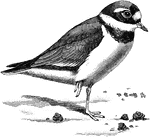
Ringed Plover
"Aegialitis hiaticola, the Ringed Plover, Sand-Lark, or Stone-runner, mistakenly called the "Ring-Dotterel"…

Indian Jacana
"Hydrophasianus chirurgus, the Indian Jacana, of most of the Indian Region, is Bronzy-brown above and…

The Great Black Woodpecker
"Picus martius, the Black Woodpecker, an inhabitant of the pine-forests of Europe and Asia to Japan,…

Diagram of the Pelvis of a Kiwi
"Pelvis of Apteryx austrlis. Lateral view. a, Acetabulum; il, ilium; is, ischium; p, pectineal process…

Diagram of the Skull of a Wild Duck
"Skull of a Wild Duck (Anus boscas), from the side. ag, Angular; als, alisphenoid; ar, articular; bt,…

Mechanical Drawing of a Metal Cylinder
"Steam is admitted under pressure for a boiler into a metal cylinder behind a piston, as represented…

Outside View of the Tabernacle
The outside view of the tabernacle shows a structure built with columns, poles, and ropes, which is…

Normal Aperture Front Primary High Vowel
Vowels have a wide, firm, and free channel, whereby the breath is modified without friction or sibilation.…

Normal Aperture Front Primary Mid Vowel
Vowels have a wide, firm, and free channel, whereby the breath is modified without friction or sibilation.…

Normal Aperture Front Primary Low Vowel
Vowels have a wide, firm, and free channel, whereby the breath is modified without friction or sibilation.…

Normal Aperture Front Wide High Vowel
Vowels have a wide, firm, and free channel, whereby the breath is modified without friction or sibilation.…

Normal Aperture Front Primary Wide Vowel
Vowels have a wide, firm, and free channel, whereby the breath is modified without friction or sibilation.…
Normal Aperture Front Wide Low Vowel
Vowels have a wide, firm, and free channel, whereby the breath is modified without friction or sibilation.…

Round Front Primary High Vowel
Vowels have a wide, firm, and free channel, whereby the breath is modified without friction or sibilation.…

